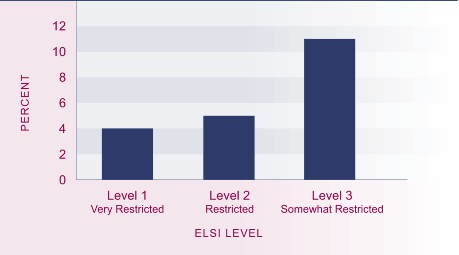Population with low living standards
Definition
The proportion of the population with a "somewhat
restricted", "restricted" and "very restricted" standard of living: Levels 1–3 of the Economic Living Standard Index (ELSI).
Relevance
ELSI is an indicator of how people are living in terms
of their possessions and activities and how they get by financially. Having
a low living standard limits a person’s ability to participate in the wider
society, curtails their quality of life, and can have negative long-term
consequences across a wide range of social and economic outcomes.
Current level
In 2000, 4 percent of the total population had "very
restricted" living standards, 5 percent had "restricted" living standards and a further 11 percent had "somewhat restricted" living standards. In total, 20 percent of the population had living standards
in the bottom three levels of the ELSI scale.
Figure EC4.1 Proportion of the population with lower living standards,
2000

Source: Krishnan et al (2002) p40
Population group differences
Groups with a higher-than-average prevalence
of low living standards include sole-parent families (51 percent), families who rely on income-tested
benefits (57 percent), families with dependent children (particularly larger
families), Māori and Pacific peoples (39 percent and 42 percent, respectively), and those
living in rented dwellings. Dependent children are more at risk of low living
standards than the population average. The probability of having low living
standards declines with age, except for a slight increase during peak child-rearing
years.
Table EC4.1 Proportion of population and economic families with low
living standards
(ELSI Levels 1–3), 2000
| |
Percent |
| Total population |
20 |
| Males |
18 |
| Females |
21 |
| Dependent
children (under 18 years) |
29 |
| 18–24 years |
I6 |
| 25–44 years |
19 |
| 45–64 years |
16 |
| 65 years and
over |
7 |
| |
|
| Total economic
families |
18 |
| By number
of children and family type |
|
| With one dependent
child |
25 |
| With two dependent
children |
24 |
| With three
or more dependent children |
35 |
| Sole-parent
family |
51 |
| Two-parent
family |
18 |
| By ethnic
group |
|
| With any Māori
members |
39 |
| With any Pacific
members |
42 |
| With any European/Pākehā members |
15 |
| With any "Other" ethnic
group members |
22 |
| By main source
of income |
|
| New Zealand Superannuation |
7 |
| Income-tested
benefits |
57 |
| Market income |
14 |
| By housing
tenure |
|
| Rented – Housing New Zealand |
63 |
| Rented – Private |
33 |
| Rented – Local
Authority |
30 |
| Owned with
mortgage |
22 |
| Owned without
mortgage |
8 |
Source: Krishnan et al (2002)
|

